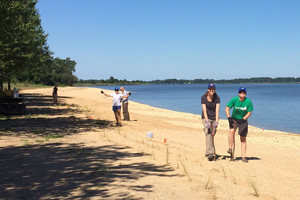National Wildlife Federation, Maryland Department of Natural Resources and Queen Anne’s County Officials Launch First-of-its Kind, Climate Adaptive Shoreline
 Today, officials from the National Wildlife Federation, the state of Maryland and Queen Anne’s County held a ribbon-cutting ceremony for the Conquest Preserve Living Shoreline Project on the banks of the Chester River. The project is one of the first living shoreline projects in the country to incorporate sea level rise projections into its design from the outset, in an attempt to mitigate some of the damaging effects of climate change in a cost-effective and natural way.
Today, officials from the National Wildlife Federation, the state of Maryland and Queen Anne’s County held a ribbon-cutting ceremony for the Conquest Preserve Living Shoreline Project on the banks of the Chester River. The project is one of the first living shoreline projects in the country to incorporate sea level rise projections into its design from the outset, in an attempt to mitigate some of the damaging effects of climate change in a cost-effective and natural way.
“The National Wildlife Federation is proud to have spearheaded such an innovative project right on the banks of the Chesapeake Bay, one of our nation’s most prized natural resources,” said Dr. Bruce Stein, National Wildlife Federation’s Associate Vice President for Conservation Science and Climate Adaptation. “The Conquest Preserve Living Shoreline is a great example of how climate-smart conservation can improve habitat while also providing social and economic benefits to local communities.”
Other attendees at the event included Maryland Governor’s Office Deputy Chief of Staff Jeannie Haddaway-Riccio; Maryland Board of Public Works Executive Secretary Sheila C. McDonald; Maryland Department of Natural Resources Secretary Mark Belton; Maryland Senator Stephen S. Hershey Jr. (R-Dist. 36); Maryland Delegate Steven J. Arentz (R-Dist. 36); Maryland Delegate Jefferson L. Ghrist (R-Dist. 36); Queen Anne’s County Commissioners James J. Moran, Steve Wilson and Jack N. Wilson Jr. and other county staff; and Wildlife Conservation Society Climate Adaptation Fund Program Manager Liz Tully.
“Maryland is once again a national leader in using cost-effective and innovative solutions to protect and restore our environment and precious natural resources,” Secretary Mark Belton said. “This living shoreline project serves as a pilot to test state-of-the-art approaches, while stabilizing this public beach by reducing erosion and increasing wildlife habitat.”
Living shorelines projects use natural materials, as opposed to hard infrastructure such as seawalls and bulkheads, to reduce erosion, stormwater runoff and habitat loss. The Conquest Preserve project is the first in the country to use a “shingle beach” design, consisting of pebbles or small- to medium-sized cobbles, rather than the typical fine sand. While they provide some stability, the lightweight cobbles are not completely static and move slightly with the tide. This allows the shoreline to shift and respond to wave action and rising sea-levels into the future.
The living shoreline stabilizes the public beach by reducing erosion and increasing marsh grass habitat for wildlife in the near term, as well as providing a natural barrier to projected sea level rise associated with climate change. As sea levels rise and wave action increases, the cobblestone, dunes and marsh grass that make up the shoreline gradually migrate upland and inland, rather than being overcome or destroyed.
Small dunes are incorporated into approximately one-third of the shoreline at Conquest Preserve, serving as a barrier to storms and rising tides. The dunes will migrate inland over time into the flat and open areas behind them. The dunes also halt upland beach erosion and create a small freshwater wetland, which will provide habitat for migratory birds and other wildlife.
The water level has been rising steadily along the shores of the Chesapeake Bay: current estimates predict sea level rise of over 3.5 feet by the end of this century. Living shorelines are increasingly being used as a tool to combat the damage to habitats and other natural resources from rising seas. With another project in Queen Anne’s County, the Windy Hill Living Shoreline project, being the first in the country to proactively include climate resiliency into the design, the county is becoming a hotspot for shoreline innovation.
Designed by Albert McCullough, owner of Sustainable Science LLC, the Conquest Preserve project was completed during August 2016, and cost approximately $270,000 – more than 20 percent less than other living shoreline projects, which can cost upward of $350,000.
“The Wildlife Conservation Society’s Climate Adaptation Fund strives to make the integration of climate adaptation considerations into all conservation actions a standard practice,” said Darren Long at the Wildlife Conservation Society. “The National Wildlife Federation’s climate-smart living shoreline at Conquest Beach directly supports that mission and will serve as a model for on-the-ground conservation in the future.”

 1-888-373-7888
1-888-373-7888 233733
233733